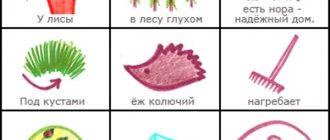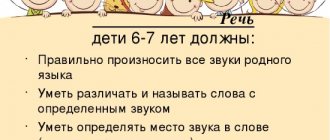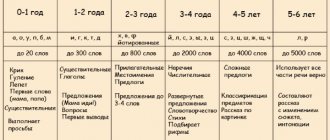What is diction and why is it important?
Diction is the correct pronunciation of sounds, corresponding to the rules of the Russian language. The intelligibility of words depends on the clarity and intensity of pronunciation of consonant sounds.
The ability to correctly pronounce verbal text is important not only for people in public professions. Good diction makes it possible to accurately convey your thoughts to other people and establish mutual understanding. After all, every pronounced sound participates in the transmission of the word, its meaning and meaning.
Severe speech impairments in a child adversely affect his mental development and behavior. An ordinary trip to the store or a conversation on the street turns into severe psychological trauma for the child. He is embarrassed by his defects, withdraws, and communication with peers fades away. The reaction of others to speech disorders (ridicule, mimicry) further aggravates the problem.
General recommendations for improving English pronunciation
The phonetics of the English language is very far from our native speech: for 26 letters of the alphabet, the English have 44 sounds, some of which do not even have remote matches in the Russian language. Therefore, we advise you to immediately abandon all analogies and learn the sounds of English from scratch.
First of all, let's note the English articulation. It is characterized by the following features:
- When a word is pronounced, the tongue is pulled back a little and spread out.
- The lips stretch slightly, and the exhalation of air is sharp and abrupt.
- Vowel sounds, depending on their position in the word, can be pronounced drawn out or, conversely, briefly.
- The clarity of most consonant sounds is achieved by resting the tip of the tongue on the alveoli (upper palate). There are no soft consonants.
These are the general rules of English pronunciation for beginners. In general, each letter has its own articulatory features and we advise you to work with them carefully. You should start by becoming familiar with the alphabet and the sounds of individual letters. Then various letter combinations and types of syllables are studied, which also affect the correct pronunciation of the word.
The theory about the rules of pronunciation of English letters with examples and detailed explanations is presented in the next article. And this material contains simplified English phonetics for children with pictures and audio that will attract the attention of children and will not let them get bored. Today we will have a little speech gymnastics on complex phonetic situations, and then practical work on all the sounds of the English language.
Why it's time to work on your diction
Important! All pronunciation deficiencies are formed in childhood. The main cause of speech defects is improper use of the speech apparatus.
Pronunciation correction is required if the following defects are present:
- Distortion of sounds. Incorrect pronunciation of sounds: burr, lisp.
- Sound replacement. If one sound is replaced by another. For example: door-door.
- Loss of sound. Absence of sound in different parts of a word. For example: fish-fish.
Consonant sounds create the framework of speech; without them, it becomes formless and incomprehensible. It is the accuracy of the pronunciation of consonants that is the main goal in working on diction.
Enemies of beautiful speech
Beautiful speech gives a positive impression of a person and encourages further communication. It is important to correctly formulate your thoughts, change the tempo and timbre of your voice.
The main enemies of pure, beautiful speech are unnecessary words, the so-called parasites. For example: so, that means, do you understand, etc. They clog up speech, do not carry any information and complicate the understanding of the speaker’s speech.
Swear words and jargon do not create the most favorable impression of your interlocutor. A person with a good upbringing is unlikely to be familiar with such expressions.
Types of exercises for developing diction and clarity of speech
To achieve clear and correct sound pronunciation, many speech therapy techniques have been developed. Regular exercise promotes competent speech and good diction.
Types of exercises:
- Articulation gymnastics. It is a preparatory stage in working on diction. Low mobility of the speech apparatus does not allow children to pronounce sounds correctly. Articulatory gymnastics forces the organs to work in a coordinated manner.
- Working with breathing. Breathing training is necessary to increase the endurance of the vocal cords.
- Pronunciation of tongue twisters. This is a unique and simple material for working on speech defects. Allows you to achieve clarity of pronunciation.
- Diction tables. Designed to develop correct pronunciation of consonants in difficult combinations. They load the speech muscles, developing their activity.
Diction exercises
Many parents are interested in the question: how to train good diction and have competent speech?
Working on diction involves training your voice and proper breathing. The following exercises are suitable for this:
- Stand up straight. Inhale sharply through your nose as much air as possible. Hold your breath for a few seconds and exhale just as sharply.
- Inhale, hold your breath for 3-4 seconds, exhale slowly, saying: rrrrr.
- Write down a few hard-to-pronounce words on a piece of paper, for example: expressionism, electrometallurgical, armored personnel carrier, etc. Repeat them until you learn to pronounce all the letters clearly.
- Take any short poem and read it with your mouth closed. The goal is to speak loudly and clearly so that you are heard and understood as best as possible.
Articulation apparatus training
Articulatory gymnastics must be performed daily; it is used as a warm-up before main training. Each exercise to improve diction is repeated 8-10 times. They are done in a calm environment in front of a mirror. First, perform the task at a slow pace so that the child can see the process.
- “Smile” is an exercise for developing diction and training the circular muscles of the mouth. The lips are drawn out as if for a kiss for 2 seconds. Then they break into a smile for the same time.
- “Shovel” is an activity for training speech and diction, which children really like. The tongue is relaxed, the mouth is slightly open. The tip of the tongue touches the lower lip and is held in this position for 10 seconds. It is important not to move or strain them.
- "Cupid's bow". Perfectly develops the circular muscles of the lips. Collect your lips into a tube and stretch them as far as possible. Make circular movements with your lips clockwise, then counterclockwise.
- "Horse". Stretches the hyoid fold of the tongue. The tip of the tongue is sucked to the upper palate. The clicking is done at first at a slow pace, then faster. Performed 15-20 times.
- "Snake". Trains the lateral muscles of the tongue, stretches the frenulum under the tongue. The mouth is wide open. The tongue protrudes forward, stretches out and becomes narrow. Then it quickly hides back into its mouth. Performed at an average pace 5-6 times.
Breathing training
Diction training with the help of breathing exercises helps in the correct production of sound and voice, strengthens its strength and expands its range. Good speaking technique is impossible without proper breathing, so all exercises are aimed at working the diaphragm:
- “Blow out the candle.” You will need a strip of paper. Bring it to your mouth at a distance of 5 cm. Pull out your lips, as if blowing out a candle. Start blowing slowly on the strip so that it is in the same position. It should not rise or fall. Imagine that you put a candle flame and hold it in that position. Exhalation is not interrupted.
- Tilts. An exercise to develop diction, train the breathing rhythm when moving. Standing, feet shoulder-width apart, keep your hands on your belt. Slowly tilt your body forward, inhale through your nose, and gradually return to the starting position while exhaling.
- Exercises to train chest breathing. Stand up, relax your upper torso. Take a slight breath in through your nose, as if smelling a flower, then exhale smoothly with the sound: pfffff.
- "10 candles" This activity helps train the diaphragmatic muscles. Imagine that there are 3 candles in front of you. Try to blow them out with one exhalation, without taking in air. Then 5, 7, 10 candles. There is no need to draw in a lot of air, the volume should be the same as when blowing out three candles, but it must be divided into several portions.
Tongue twisters for the development of diction
How to develop good diction quickly and without much effort? The most accessible way is tongue twisters. First, say it slowly and silently, using only your lips. Then repeat, pronouncing each sound clearly. If you can pronounce all the sounds at a calm pace, you can increase the speed.
Tongue twisters for practicing various sounds:
- Sound "Zh". The beetle flew, buzzed, buzzed, the Beetle ran, buzzed, buzzed, the beetle sat on a branch and said: B-buzz. I'm so tired of buzzing!
- Sound "K". The cuckoo crowed to the cuckoo all day, and the cuckoo said to the cuckoo: What beautiful words in the song! And she croaked loudly: “Kwa!” Kwa-kwa-kwa!
- Sound "Sh". Shura sewed a hat and pants for the bear, Shura sewed a cute sarafan for the bunny. Shura is in a hurry to sew a scarf, It is made of silk, the silk rustles.
- Sound "B". If only mushrooms had not grown in the forest, the squirrels would have had trouble in the winter - Everyone would have been left without food. It is necessary to practice diction using tongue twisters every day for 15-20 minutes.
Examples of quatrains for training
Poems are not only capable of developing memory in children, but are powerful exercises for the development of diction.
- Be-e-e, listen to the lamb's mother, the lamb's brother says, if you beat your thumbs like a slacker, you will be beaten.
- Eat, Elena, have fun, eat and don’t skimp on the porridge. If you don’t eat, Lena, you’ll definitely get sick.
- Rain, rain, no rain, rain, rain, wait: the grandfather is going home, the granddaughter is waiting for the grandfather at home.
- Petya is very friendly with the pony, and Petya serves the pony faithfully. Petya will pet the pony - the pony will give Petya a ride.
Repeated repetition of text words trains diction and develops speech muscles. When reading poetry, you should pronounce sounds clearly and expressively, and monitor your breathing and intonation.
To practice sounds B and P
Exercises to correct pronunciation deficiencies should begin with correct articulation. Say the sound in front of the mirror, pay attention to the accuracy of the articulatory pattern. First, pronounce the sounds individually, then introduce them into the speech stream.
- Diction table. Conducted daily, starting with articulation gymnastics. Difficult to pronounce combinations allow you to load all the facial muscles and develop their mobility. The phrases are repeated many times: PTKU-PTKO-PTKE-PTKE-PTKA; KTPTUP-KTPTOP-KTPTAP; BDGO-BDGU-BDGI-BDGY-BDGE; GBDUPT-GBDOPT-GBDEPT. When the child learns to clearly pronounce sounds, you can move on to more complex combinations: PTKU-BDGU, PRESH-PES, PRE-PO-BEST, BRUSH-PAS, BRISH-BIS, BDGY-BA-DATS.
- Tongue twisters: From the clatter of hooves, dust flies across the field; Killed a beaver, but didn't get the beaver.
- "Cork". For clear pronunciation of the sounds P, B, good development of the lip muscles is necessary. This exercise is well suited for training them: the lips are tightly closed, the edges are taut. Using a stream of air in the mouth, sharply break through the bow. As if you are pushing out a cork with pursed lips.
Important! Do not relax your lip muscles, they should open under the air pressure!
For clear pronunciation of V and F
Articulation: The upper lip is raised, the lower lip is extended and pressed against the upper teeth, which are visible. When pronouncing, a stream of air is exhaled between the upper teeth and lower lip. For sound B, a voice is added.
- "Hedgehog". The child should imitate the snorting of a hedgehog. Taking a deep breath and pressing your bottom lip to your teeth.
- Chains of syllables. At the beginning of the lesson, the baby pronounces the same chain of syllables: va-va-va, fu-fu-fu. Then more complex ones: wa-woo-wee, fa-fu-fi.
- "Breeze". The baby bites his lower lip with his upper incisors and blows it out of his mouth with a stream of air.
For correct pronunciation of G, K and X
Articulation: Lips and teeth are not closed. The tongue is arched, with its back pressed to the palate. When pronouncing sounds, a stream of air escapes between the palate and the tongue.
- Ask your child to say the syllables: ta-ta-ta. At this time, use a teaspoon to lower the tip of your tongue and move it slightly deeper into your mouth. The child will make a new sound: tya-ka-kya. After several lessons, the spoon is removed and the baby reproduces the sound K independently. Similar exercises are carried out on G, only the child says: yes-yes-yes, if the sound X is corrected, repeat: sa-sa-sa.
- Say alternately: K-g, k-g, k-g, k-g, k-g.
- Read each time, increase the pace: Kat-ket-kit-kai-kay-cube-kish; Hat-hat-hid-hor-hys-khas; Gus-gus-ger-gus-gas-hum.
- To consolidate the results, use tongue twisters: I praise Halva! I praise Halva!; The chicken is pecking at the kibble, smoking a Turkish pipe; The capercaillie is deaf, but not stupid.
For sounds L and M
- To correct a defect in the pronunciation of the sound L, you can use the following method: Hold the tip of your tongue with your teeth and stretch out: ыыыыы. In this position of the speech organs, the sound L is produced.
- The formation of the sound L should involve not the lips, but the tongue. To form correct articulation, the following exercise is suitable: Hold the corners of your mouth with your fingers so that they do not move, pronounce the sound, concentrating on the work of the tongue.
- "Hard-soft." A beautiful exercise for good diction and speech. Read the first syllable firmly, the second softly: WE-MI; MA-MYA; MU-MU; ME-ME; MO-ME
- "Who's on M?" Read the story to your child, then ask him to name all the words starting with the letter M that appear in the text. Masha has crayons. Masha draws a bear, a jellyfish, a poppy, and a ball. Masha showed the drawings to her mother. Mom said: Well done, Masha!
For sounds Ch and Sh
- The training of hissing words should begin with words where they occur at the beginning: scarf-fur coat-hat-noise; sharpie-rustle-mine-tent; tire-chic-awil-screen.
- Word combinations rich in necessary sounds: The rustle of mice, the rustle of leaves; Large wide brimmed hat.
- Pronouncing forward-backward syllables: CHA-ACH, CHI-ICH, CHU-UCH, CHE-ECH.
- Reading quatrains: What kind of dance is Shuttle? Heel on heel, and then tap dance - fun and clear!
Many children have difficulty with certain sounds. It’s not at all difficult to help them, you just need to do training exercises regularly. For better speech development, talk to your children and encourage them when they don’t succeed at something right away.
Paired sounds in English: exercises
Again, I will repeat a typical mistake for us - deafening the final sound and thus changing the meaning of the word: bu zz
- bu s (buzz - bus), ri se - ri ce (rise - rice)
. Listen to how Stephen Curtis Chapman pronounces the /z/ sound in the song “His Eyes.”
Hi s
eye
s
are alway
s
upon us;
Hi s
eye
s
never clos
e
in sleep.
And no matter where you go, You will alway s
be in Hi
s
eye
s
, in Hi
s
eye
s
.
(His eyes are always looking at us, his eyes never close in sleep. And no matter where you go, you will always be in his eyes)
From 0:47 to 1:11
Task No. 5.
You know it







